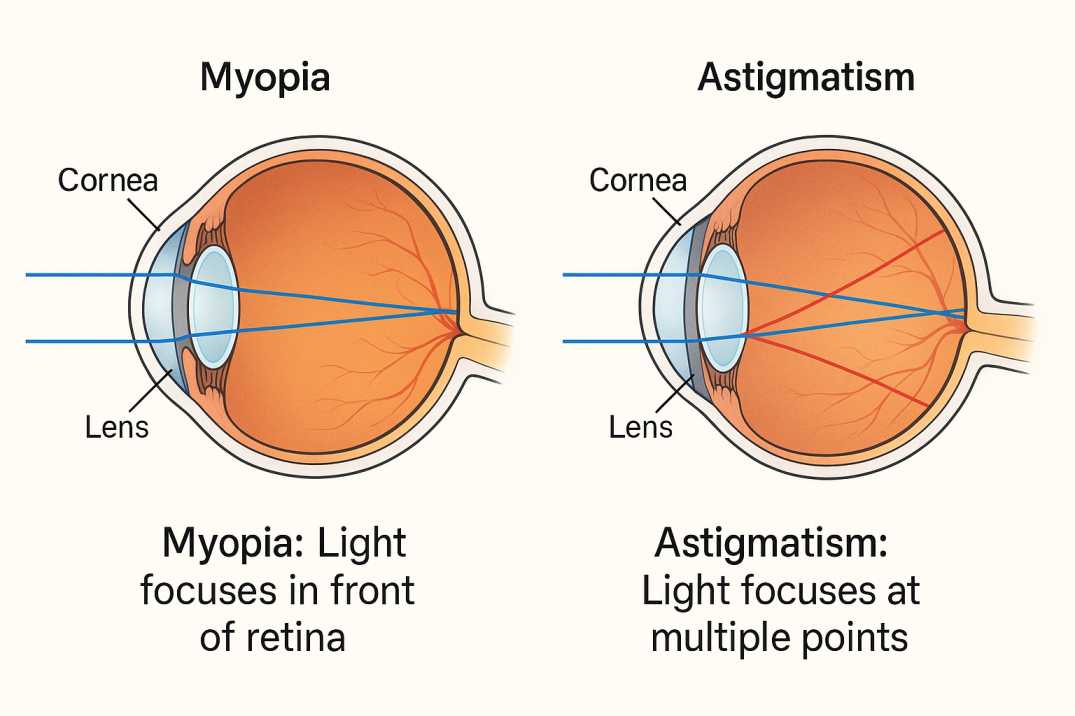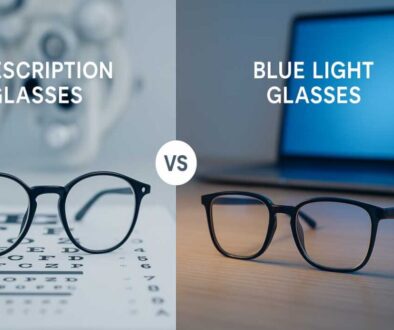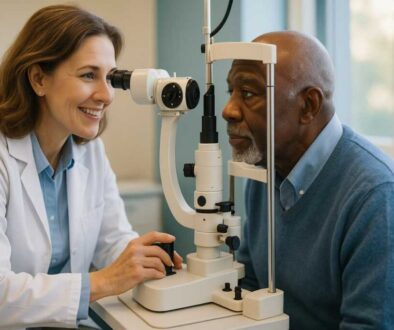Do You Have Astigmatism or Myopia? Find Out Here
Bottom Line Up Front: If you’re experiencing blurry vision but aren’t sure whether you have astigmatism or myopia, the key difference is simple: myopia (nearsightedness) makes distant objects blurry while close objects stay clear, whereas astigmatism causes blurry vision at all distances. Both refractive errors are highly treatable with glasses, contacts, or surgery, but proper diagnosis requires a comprehensive eye exam with an experienced Fort Collins eye care professional.
Understanding Astigmatism vs Myopia: A Complete Guide
Vision problems affect millions of people, yet many don’t realize they could be seeing much better. At Poudre Valley Eyecare, Fort Collins’ most trusted eye care practice for over 25 years, we’ve helped thousands of Northern Colorado families understand and manage common refractive errors like astigmatism and myopia. Our comprehensive approach includes accepting Medicare and Medicaid, ensuring quality eye care is accessible to everyone in our community.
Understanding the difference between these two common eye conditions is the first step toward clearer vision and better eye health. This comprehensive guide explores what sets astigmatism and myopia apart, how to recognize their symptoms, and what treatment options can help you see your world more clearly.
Key Statistics: Astigmatism affects 36% of U.S. adults, while myopia affects 41.6% of Americans, with both conditions becoming increasingly common.
Understanding Myopia (Nearsightedness): Symptoms and Causes
What Is Myopia?
Myopia, commonly called nearsightedness, occurs when your eyeball is too long or your cornea has too much curvature. This structural difference causes light to focus in front of your retina instead of directly on it, making distant objects appear blurry while near objects remain clear.
Consider this analogy: if you can read a book comfortably but struggle to see road signs or the classroom whiteboard clearly, you likely have myopia. This refractive error typically develops during childhood and often progresses until around age 20, when it usually stabilizes.
Clinical Note: The elongated eyeball characteristic of myopia increases the risk of serious eye complications later in life, making early detection and management crucial.
Key Myopia Symptoms to Watch For
Myopia symptoms primarily affect your ability to see distant objects clearly:
Distance Vision Problems:
- Difficulty seeing road signs while driving
- Squinting to see the TV from across the room
- Trouble reading whiteboards or presentations at school or work
- Blurry vision when looking at distant objects
Other Common Myopia Signs:
- Frequent headaches from eye strain
- Eye fatigue after visual tasks
- Sitting close to the TV or holding books very close
- Difficulty with night vision
Important Note for Parents: Children with myopia may not realize their vision is blurry since they’re used to seeing this way. Watch for signs like poor school performance, frequent squinting, or complaints of headaches.
The Growing Myopia Epidemic
Myopia is becoming increasingly common worldwide. Recent data shows myopia affects approximately 41.6% of Americans as of 2025, with experts predicting this number could reach 50% of the global population by 2050. This represents a dramatic increase from just 22% globally in 2000. Factors contributing to this myopia increase include:
- Increased screen time and digital device usage
- Less time spent outdoors
- More close-up work, like reading and studying
- Genetic predisposition
Understanding Astigmatism: When All Vision Gets Blurry
What Is Astigmatism?
Astigmatism occurs when your cornea or lens has an irregular, oval shape instead of being perfectly round. This structural irregularity prevents light from focusing on a single point on your retina, instead creating multiple focal points that result in blurred or distorted vision at all distances.
To visualize this effect, imagine looking through the bottom of a water glass—that characteristic waviness and distortion mirrors how astigmatism affects your visual perception. Unlike myopia, which primarily compromises distance vision, astigmatism can impact the clarity of both near and far objects.
Medical Insight: Most people have some degree of astigmatism, but only cases of 1.0 diopter or greater typically require correction.
Key Astigmatism Symptoms to Recognize
Astigmatism demonstrates remarkable prevalence, affecting approximately 36% of adults in the United States and up to 40% of adults worldwide, according to recent epidemiological studies. Unlike myopia, astigmatism symptoms can vary significantly between individuals based on the severity and type of corneal irregularity:
Primary Astigmatism Vision Problems:
- Blurry or distorted vision at all distances
- Objects appearing elongated, tilted, or stretched
- Difficulty discerning fine details clearly
- Double vision in severe, untreated cases
Associated Physical Symptoms:
- Chronic eye strain and visual fatigue
- Frequent headaches, particularly after visual tasks
- Persistent squinting to achieve clearer focus
- Increased sensitivity to bright lights and glare
- Prominent halos or starbursts around light sources, especially problematic during night driving
Professional Note: Children with astigmatism may unconsciously tilt their heads to compensate for visual distortion, a behavior that warrants immediate eye examination.
Types of Astigmatism
There are two main astigmatism types:
- Corneal astigmatism: The cornea has mismatched curves
- Lenticular astigmatism: The lens inside your eye has mismatched curves
Both astigmatism types can cause similar symptoms and are corrected with similar treatments.
Astigmatism vs Myopia: How to Tell the Difference
While both astigmatism and myopia can cause blurry vision and eye strain, there are key differences that can help you identify which condition you might have:
Primary Vision Difference
- Myopia (nearsightedness): Clear near vision, blurry distance vision
- Astigmatism: Blurry vision at all distances
Symptom Comparison: Astigmatism vs Myopia
| Symptom | Myopia | Astigmatism |
|---|---|---|
| Distant objects blurry | ✓ | ✓ |
| Near objects blurry | ✗ | ✓ |
| Headaches | ✓ | ✓ |
| Eye strain | ✓ | ✓ |
| Night vision problems | ✓ | ✓ |
| Halos around lights | Sometimes | ✓ |
| Distorted/tilted objects | ✗ | ✓ |
Age of Onset: Astigmatism vs Myopia
- Myopia: Usually develops in childhood (ages 6-14) and progresses until the early twenties
- Astigmatism: Often present from birth, but can develop or change at any age.
Can You Have Both Astigmatism and Myopia Together?
Yes, absolutely! It’s quite common to have both astigmatism and myopia simultaneously. When this happens, you’ll experience:
- Blurry vision at all distances (more severe than either condition alone)
- The need for corrective lenses that address both issues
- Potential for more complex prescription requirements
If you have both conditions, your Fort Collins eye care professional will prescribe lenses with both spherical power (for myopia) and cylindrical power (for astigmatism) to provide clear vision at all distances.
Simple At-Home Vision Tests for Astigmatism and Myopia
While these vision tests can give you an idea of potential vision issues, only a comprehensive eye exam can provide an accurate diagnosis of astigmatism or myopia.
Basic Myopia Test
- Stand 20 feet from a wall
- Cover one eye and read the smallest text you can see clearly
- Repeat with the other eye
- If distant text appears blurry but you can read it up close easily, you may have myopia.
Simple Astigmatism Test
- Look at a clock face or radial pattern from 10 feet away
- Cover one eye, then the other
- If some lines appear darker or clearer than others, you may have astigmatism.m
Remember: These vision tests are screening tools only. Professional examination is essential for proper astigmatism and myopia diagnosis and treatment.
Professional Eye Exam: Diagnosing Astigmatism and Myopia
Comprehensive Eye Examination Components
A thorough eye examination employs multiple diagnostic techniques to accurately identify and quantify astigmatism and myopia:
Visual Acuity Assessment:
- Standardized eye chart testing at various distances to detect myopia and astigmatism
- Precise measurement of visual clarity across different ranges
- Comparison of corrected versus uncorrected vision
Advanced Refraction Analysis:
- Systematic lens testing to determine the exact astigmatism or myopia prescription requirements
- Utilization of sophisticated phoropters for precise vision correction optimization
- Assessment of both eyes individually and in coordination
Corneal Topography and Keratometry:
- Detailed corneal curvature mapping for comprehensive astigmatism diagnosis
- Detection of irregular astigmatism patterns that may indicate underlying conditions
- Quantification of astigmatic power and axis orientation
Comprehensive Ocular Health Evaluation:
- Thorough examination of internal eye structures using advanced imaging
- Screening for comorbid conditions that may compound vision issues
- Assessment of eye muscle function and coordination
Technology Note: Modern diagnostic equipment, including retinal imaging and corneal topography, provides unprecedented accuracy in diagnosing refractive errors.
When to Schedule Your Fort Collins Eye Exam
Seek professional astigmatism and myopia care if you experience:
- Any changes in vision quality
- Frequent headaches or eye strain
- Difficulty with daily activities due to vision problems
- Family history of eye conditions
For Children:
- First eye exam by age 1
- Follow-up exams at ages 3-5
- Annual exams once school begins
- Immediately, if vision problems are suspected
Treatment Options: From Glasses to Surgery for Astigmatism and Myopia
Corrective Lenses: First-Line Astigmatism and Myopia Treatment
Eyeglasses for Astigmatism and Myopia:
- Most common and safest astigmatism and myopia treatment option
- Can correct both myopia and astigmatism effectively in a single lens
- Available in various lens materials and coatings
- Provide consistent, reliable vision correction for both conditions
Contact Lenses for Astigmatism and Myopia:
- Offer a wider field of view than glasses for myopia and astigmatism
- Better for active lifestyles and sports
- Special “toric” lenses are available specifically for astigmatism correction
- Daily disposable options are available for both myopia and astigmatism
Advanced Treatment Options
Refractive Surgery (LASIK and PRK):
- Permanent vision correction for eligible candidates
- Reshapes the cornea using advanced laser technology
- High success rates for both myopia and astigmatism
- At Poudre Valley Eyecare, we carefully evaluate each patient’s candidacy and provide honest recommendations about surgical options
Orthokeratology (Ortho-K):
- Special overnight contact lenses that temporarily reshape the cornea
- Provides clear vision during the day without glasses or contacts
- Particularly effective for myopia control in children
Myopia Management: Slowing Myopia Progression
Recent research has shown promising results in slowing myopia progression, especially in children:
Low-Dose Atropine Eye Drops for Myopia:
- Clinical trials show a significant reduction in myopia progression
- Minimal side effects compared to higher concentrations
- Particularly effective for myopia management when started early
Specialized Contact Lenses for Myopia Control:
- MiSight daily disposable lenses approved for myopia control
- Dual-focus design helps slow eye elongation and myopia progression
- Multifocal soft lenses showing promising myopia management results
Lifestyle Modifications for Myopia Prevention:
- Increased outdoor time (2+ hours daily)
- Following the 20-20-20 rule for screen use
- Proper lighting for reading and close work
- Regular breaks from near tasks
Recent Breakthrough Research (2024-2025)
Cutting-Edge Treatment Developments
Light Therapy:
- Repeated Low-Level Red Light (RLRL) therapy showing promise
- 10-15 minute daily sessions with specific wavelengths
- Studies report a 50-60% reduction in myopia progression
Advanced Spectacle Lenses:
- Defocus Incorporated Multiple Segments (DIMS) technology
- Highly Aspherical Lenslets (HAL) for pre-myopia treatment
- Diffusion Optics Technology (DOT) lenses with a breakthrough FDA designation
Combination Therapies:
- Atropine drops combined with specialty lenses
- Orthokeratology with low-dose atropine showing enhanced efficacy
- Personalized treatment approaches based on individual risk factors
Research-Backed Statistics
- 6-year studies show specialized contact lenses can slow eye growth by 0.52mm compared to single-vision lenses
- Low-dose atropine (0.01-0.02%) reduces myopia progression by 30-50%
- Combination therapies may offer even greater benefits than single treatments
What to Do Next: Your Action Plan
Immediate Steps
- Schedule a Comprehensive Eye Exam
- Don’t wait if you’re experiencing vision problems
- At Poudre Valley Eyecare, our comprehensive exams include the latest diagnostic technology and retinal imaging
- We accept most insurance plans, including Medicare and Medicaid, making quality eye care accessible
- Annual exams are essential for monitoring changes and preventing complications
- Keep Track of Symptoms
- Note when vision problems occur
- Record any eye strain or headaches
- Monitor changes in vision quality
- Consider Your Family History
- Inform your eye care provider about family eye conditions
- Children with myopic parents have a higher risk
- Genetic factors influence treatment decisions
Long-Term Eye Health Strategies
Lifestyle Modifications:
- Spend at least 2 hours outdoors daily
- Take regular breaks from screen time
- Ensure proper lighting for reading and work
- Maintain a healthy diet rich in eye-healthy nutrients
Regular Monitoring:
- Annual comprehensive eye exams
- More frequent visits if myopia is progressing
- Monitor prescription changes over time
- Stay alert to new symptoms or vision changes
Prevention and Management Tips
For Adults
- Use proper lighting when reading or working
- Position computer screens 20-26 inches away
- Blink frequently to prevent dry eyes
- Wear sunglasses for UV protection
- Consider computer glasses for extensive screen use
For Children
- Encourage outdoor play and activities
- Limit recreational screen time
- Ensure good posture during close work
- Provide adequate lighting for homework
- Schedule regular eye exams even without symptoms
Environmental Factors
- Maintain proper humidity levels in your home
- Use air purifiers to reduce allergens
- Keep work and study areas well-lit
- Consider blue light filtering for evening screen use
When to Seek Urgent Eye Care
Contact an eye care professional immediately if you experience:
- Sudden vision changes or loss
- Flashes of light or new floaters
- Severe eye pain or headaches
- Double vision that doesn’t resolve
- Signs of eye infection (redness, discharge, pain)
The Importance of Professional Care
While this comprehensive guide provides evidence-based information about astigmatism and myopia, professional eye care remains irreplaceable for optimal outcomes. At Poudre Valley Eyecare, we’ve served as Fort Collins’ trusted partner in lifelong eye health for over 25 years, understanding that every patient’s vision needs require individualized assessment and care.
Our evidence-based approach reflects core clinical values:
- Patient-Centered Care Excellence: Every clinical decision prioritizes patient comfort, comprehension, and optimal visual outcomes through shared decision-making
- Universal Healthcare Accessibility: Quality eye care should transcend economic barriers—our acceptance of Medicare, Medicaid, and comprehensive insurance plans ensures equitable access to advanced eye care
- Community Health Commitment: Our deep investment in Fort Collins families’ long-term ocular health drives our participation in vision screening programs and educational initiatives
- Clinical Excellence Standards: From routine refractive assessments to advanced myopia management protocols, every service maintains the highest evidence-based standards
Why Professional Diagnosis and Treatment Matter
Clinical Advantages of Professional Care:
- Precise identification of specific refractive errors using state-of-the-art diagnostic equipment, including corneal topography and retinal imaging
- Individualized treatment plans optimized for lifestyle, occupation, and visual demands
- Longitudinal monitoring of condition progression with advanced biometric tracking technology
- Early detection of sight-threatening complications through comprehensive ocular health assessments
- Access to cutting-edge treatment modalities and evidence-based myopia management techniques
- Immediate availability of emergency care when urgent ocular issues arise
Practice Philosophy: We believe in treating the whole person, not just the refractive error, ensuring comprehensive care that addresses both immediate vision needs and long-term ocular health.
Research Sources and Citations
This comprehensive guide is based on the latest peer-reviewed research and authoritative medical sources:
Primary Research Citations
- Holden, B.A., Fricke, T.R., Wilson, D.A., et al. (2016)
“Global Prevalence of Myopia and High Myopia and Temporal Trends from 2000 through 2050”
Ophthalmology, Volume 123, Issue 5
https://www.aaojournal.org/article/s0161-6420(16)00025-7/fulltext
Key finding: Myopia prevalence projected to reach 50% the global population by 2050 - Zadnik, K., Schulman, E., Flitcroft, I., et al. (2023)
“Efficacy and Safety of 0.01% and 0.02% Atropine for the Treatment of Pediatric Myopia Progression Over 3 Years”
JAMA Ophthalmology, Volume 141, Issue 10
https://jamanetwork.com/journals/jamaophthalmology/fullarticle/2809622
Key finding: Low-dose atropine significantly reduces myopia progression in children with minimal side effects - Vitale, S., Ellwein, L., Cotch, M.F., et al. (2008)
“Prevalence of Refractive Error in the United States, 1999-2004”
Archives of Ophthalmology, Volume 126, Issue 8
https://jamanetwork.com/journals/jamaophthalmology/fullarticle/420707
Key finding: Astigmatism affects 36% of adults in the United States, with prevalence increasing with age
These sources represent the gold standard in ophthalmologic research and provide the foundation for evidence-based myopia and astigmatism management strategies discussed in this guide.
Conclusion: Clear Vision Is Within Reach
Whether you have astigmatism, myopia, or both, the good news is that effective treatments are available. The key is understanding your symptoms, seeking a professional diagnosis, and following through with appropriate treatment.
Remember, vision problems don’t have to limit your quality of life. With proper care and the right treatment approach, you can enjoy clear, comfortable vision for years to come. If you’re experiencing any of the symptoms described in this guide, don’t wait—schedule your comprehensive eye exam today.
Your eyes deserve the best care possible, and clear vision is just an appointment away. Contact Poudre Valley Eyecare today to schedule your comprehensive eye examination and take the first step toward optimal vision health.
FAQs
-
Astigmatism causes blurry vision at all distances, while myopia only makes distant objects appear blurry. An eye exam provides a definitive diagnosis.
Please note: None of the above should be considered medical advice. If you’re having any concerns about your vision, please reach out to us immediately or see your primary care provider.





